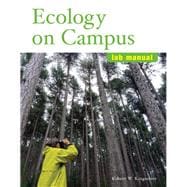
Note: Supplemental materials are not guaranteed with Rental or Used book purchases.
Purchase Benefits
| Preface Teaching and Learning Ecology in a Campus Environment | vii | ||||
|
1 | (22) | |||
|
10 | (2) | |||
|
12 | (11) | |||
|
23 | (28) | |||
|
28 | (7) | |||
|
35 | (7) | |||
|
42 | (9) | |||
|
51 | (14) | |||
|
56 | (2) | |||
|
58 | (2) | |||
|
60 | (5) | |||
|
65 | (26) | |||
|
75 | (5) | |||
|
80 | (3) | |||
|
83 | (8) | |||
|
91 | (40) | |||
|
105 | (6) | |||
|
111 | (12) | |||
|
123 | (8) | |||
|
131 | (28) | |||
|
144 | (9) | |||
|
153 | (6) | |||
|
159 | (18) | |||
|
165 | (3) | |||
|
168 | (2) | |||
|
170 | (7) | |||
|
177 | (22) | |||
|
184 | (3) | |||
|
187 | (2) | |||
|
189 | (10) | |||
|
199 | (20) | |||
|
205 | (3) | |||
|
208 | (5) | |||
|
213 | (6) | |||
|
219 | (24) | |||
|
236 | (2) | |||
|
238 | (3) | |||
|
241 | (2) | |||
|
243 | (30) | |||
|
257 | (5) | |||
|
262 | (5) | |||
|
267 | (6) | |||
|
273 | (26) | |||
|
281 | (4) | |||
|
285 | (5) | |||
|
290 | (9) | |||
|
299 | (20) | |||
|
309 | (1) | |||
|
310 | (2) | |||
|
312 | (7) | |||
|
319 | (18) | |||
|
328 | (4) | |||
|
332 | (5) | |||
|
337 | (24) | |||
|
347 | (6) | |||
|
353 | (4) | |||
|
357 | (4) | |||
|
361 | (22) | |||
|
369 | (4) | |||
|
373 | (5) | |||
|
378 | (5) | |||
|
383 | (26) | |||
|
393 | (4) | |||
|
397 | (7) | |||
|
404 | (5) | |||
|
409 | (28) | |||
|
418 | (11) | |||
|
429 | (2) | |||
|
431 | (6) | |||
| Appendix 1 Variance | 437 | (1) | |||
| Appendix 2 The t-Test | 438 | (3) | |||
| Appendix 3 Correlation and Regression | 441 | (2) | |||
| Appendix 4 Critical Values for the Mann-Whitney U-test | 443 | (1) | |||
| Appendix 5 Critical Values for the Chi-Square Test | 444 | (1) | |||
| Appendix 6 A Table of Random Numbers | 445 | (1) | |||
| Appendix 7 Writing a Laboratory Report | 446 | (3) | |||
| Glossary | 449 | (10) | |||
| Index | 459 | (8) | |||
| Credits | 467 |
The New copy of this book will include any supplemental materials advertised. Please check the title of the book to determine if it should include any access cards, study guides, lab manuals, CDs, etc.
The Used, Rental and eBook copies of this book are not guaranteed to include any supplemental materials. Typically, only the book itself is included. This is true even if the title states it includes any access cards, study guides, lab manuals, CDs, etc.